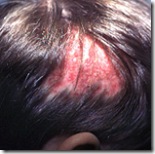Tinea Capitis
 Tinea Capitis, also known as ringworm of the scalp or tinea tonsurans, is a hair loss scalp condition, a type of superficial dermatophytosis, which is caused by fungal infection. Every geographical area has its own strain of fungi that can attack hair follicles and hair shafts, thus causing the disease: in North America, these are typically Microsporum canis and Trichophyton tonsurans.
Tinea Capitis, also known as ringworm of the scalp or tinea tonsurans, is a hair loss scalp condition, a type of superficial dermatophytosis, which is caused by fungal infection. Every geographical area has its own strain of fungi that can attack hair follicles and hair shafts, thus causing the disease: in North America, these are typically Microsporum canis and Trichophyton tonsurans.
The condition can be either inflammatory, accompanied by lesions and scarring alopecia, or non-inflammatory, clinically similar to scaly seborrheic dermatitis, and sometimes can also spread onto eyelashes and eyebrows. Severe cases of inflammatory Tinea Capitis can lead to deep scalp abscesses and permanent hair loss.
The condition was first detected and described in the 1830s by Dr. Remak and Dr. Schönlein, although the term “tinea” had been used before, approximately since the 16th century, to indicate various parasitic infections and diseases of the scalp. In the 1880s, Dr. Sabouraud clinically detected and demonstrated the specific species of Tinea Capitis fungi, and, in 1904, the disease was first treated by x-ray epilating. Effective and non-toxic treatment, using medication called griseofulvin, became available only by the 1950s.
Currently, Tinea Capitis is a widely spread fungal infection, and its incidence has a tendency to increase everywhere in the world, including urban North America. It is especially common in male children (five fold prevalence over girls), and, in the US, the most affected group are African American boys aged 3-7 years old. While in children’s scalp conditions Tinea Capitis can be responsible for more than 90% of cases, it is rare in adults, although can occur more frequently in elderly people, especially women. Internationally, the disease is most common in India and Africa.
Causative agents of Tinea Capitis (moulds and keratinophilic fungi) can be a part of normal skin and scalp flora, and, when triggered, they aggressively invade hair roots and shafts, slowly spreading and breaking infected hairs, producing crusts, and causing hair loss. Also, the condition can be caused by person-to-person transmission, since the fungi can survive on hair brushes and bed sheets for a long time. The infection first manifests as small red papules located around hairs, and later the papules become scaly and the hairs appear brittle and break easily. The lesions then spread on other scalp areas causing inflammation and alopecia. The expansion of fungi can last up to ten weeks, affecting large areas of the scalp, and often spontaneous cure occurs. The precise triggers and mechanism of Tinea Capitis still remains unclear. To arrive to exact diagnosis, different tests are used, including Wood’s light examination, mycological culture analysis, and potassium hydroxide scraping. To treat the condition, systemic oral therapy is usually required, which may include itraconazole (Sporanox®), griseofulvin (Fulvicin®), or terbinafine (Lamisil®).
Robin Makris
Posted on October 20, 2007
Filed Under Hair Loss Conditions
Comments
One Response to “Tinea Capitis”
Leave a Reply

My son who is 8 years old has tinea capitis with immflammation. I’d like to know whether his hair is permanently lost, if so what alternatives does he has to regrow his hair. How long do i have to wait to know whether his hair is permanently lost?
thanks